Hypermesh计算消声器模态
48_HyperWorks在汽车声腔模态分析中的应用_张远岭

HyperWorks在声学模态分析中的应用张远岭上海世科嘉车辆技术研发有限公司上海 201209摘要:在汽车开发阶段,分析车内声腔的声学特性对改善车内噪声有重要指导意义。
本文应用Altair公司强大的前处理软件HyperMesh建立车内声腔有限元模型, 并利用OptiStruct 进行声学模态求解,最后使用HyperView进行后处理。
通过分析获得了车内声腔的各阶固有频率和振型,为预测车内声学特性和改善声学环境提供了参考。
关键词:车内噪声,声学空腔,声学模态分析,NVH0前言随着人们生活水平的不断提高,人们对汽车的乘坐舒适性也提出了越来越高的要求,汽车NVH性能已经成为影响人们决定购买汽车的一项重要因素。
如何降低车内噪声是汽车设计过程中必须考虑的问题。
车内噪声按产生机理大致分为两类,其一是空气噪声,主要由发动机、进排气噪声通过空气传入车内的中高频噪声,另一类是结构噪声,主要由发动机、轮胎、路面等激励引起车身结构振动而向车内辐射的低频噪声。
试验研究表明,结构噪声在车内噪声中占主要地位,所以,在开发前期,如能研究车室空腔的声学特征,掌握其固有频率和声压分布,就能避免车身壁板振动引起车室空腔共鸣,合理布置车内声压分布,尽量使人耳处在模态节线位置,从而获得较好的舒适性。
1 车室声腔有限元模型的建立声腔由乘员舱内壁形成的封闭空间组成。
在HyperMesh中导入车身FE模型,利用HyperMesh的强大网格生成功能,在车身内壁与空气接触的部位生成一个封闭的面网格,划分网格时若遇到模型中倒圆、孔、冲压筋及一些面与面之间的缝隙等特征,可在不影响模型精度的前提下,尽量简化和忽略。
另外,若考虑座椅对声腔的影响,还需要在HyperMesh 中导入座椅外CAS面,生成封闭的面网格。
然后利用HyperMesh中的四面体网格生成功能可以快速的生成如图1所示的完整的声腔有限元模型,其单元基础尺寸100 mm,共有节点14704个,单元74448个。
2024版Hypermesh基础教程

自定义报告
用户可以根据自己的需求,自定义报告的格式和内容,以满足特定 的要求。
常见问题及解决方案
模型导入问题
有时候在导入模型时会出现问题,如无法导入、导入后模 型变形等。解决方案包括检查模型格式是否正确、调整导 入参数等。
02
网格划分技术
Chapter
网格类型及选择
一维网格
线单元,用于模拟一维结构,如 梁、杆等。
二维网格
面单元,用于模拟二维结构,如壳、 板等。
三维网格
体单元,用于模拟三维结构,如实 体、装配体等。
网格划分方法
01
02
03
映射网格划分
将几何模型映射到一个规 则的网格上,适用于形状 简单的结构。
自由网格划分
配置要求
Hypermesh对计算机配置有一定 要求,建议使用高性能计算机, 并配置足够的内存和硬盘空间。
许可证管理
使用Hypermesh需要获取相应的 许可证,按照许可证管理要求进 行激活和使用。
界面布局与功能
Hypermesh提供强大的几何清理 功能,可以对导入的CAD模型进 行修复、简化和优化等操作,提 高网格质量和分析效率。
载荷大小和方向
设置载荷的大小和方向,以便准确模拟实际受力情况。
载荷施加位置
在模型中选择需要施加载荷的位置,如节点、面或体。
载荷施加方式
根据模型需求,选择适当的载荷施加方式,如集中载荷、分 布载荷等。同时,可以设置载荷随时间的变化规律,以模拟 动态加载过程。
04
结构分析基础
Chapter
线性静力学分析
hypermesh与nastran模态分析流程
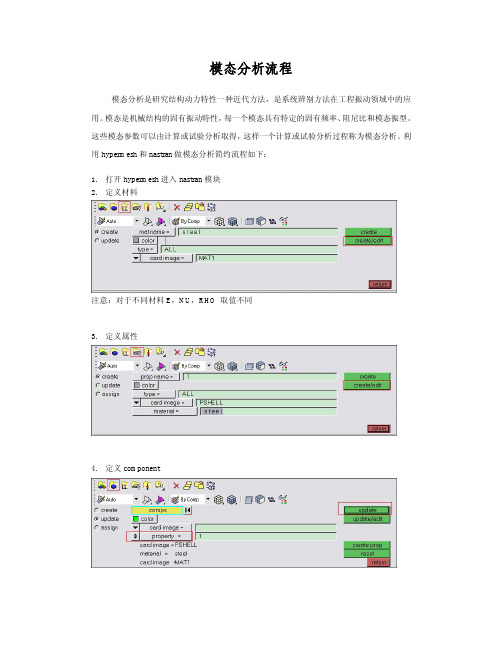
模态分析流程
模态分析是研究结构动力特性一种近代方法,是系统辨别方法在工程振动领域中的应用。
模态是机械结构的固有振动特性,每一个模态具有特定的固有频率、阻尼比和模态振型。
这些模态参数可以由计算或试验分析取得,这样一个计算或试验分析过程称为模态分析。
利用hypermesh和nastran做模态分析简约流程如下:
1.打开hypermesh进入nastran模块
2.定义材料
注意:对于不同材料E,NU,RHO 取值不同
3.定义属性
4.定义component
5.定义力
注意:设置所需模态的阶数,注意前六阶为刚体模态。
6.定义load step
设置SPC和METHOD,类型选择模态
7.定义control card
选择AUTOSPC,BAILOUT为0,DORMM为0,PARAM为-1 8.保存文件,在nastran中进行计算。
基于Hypermesh与ansys的模态分析
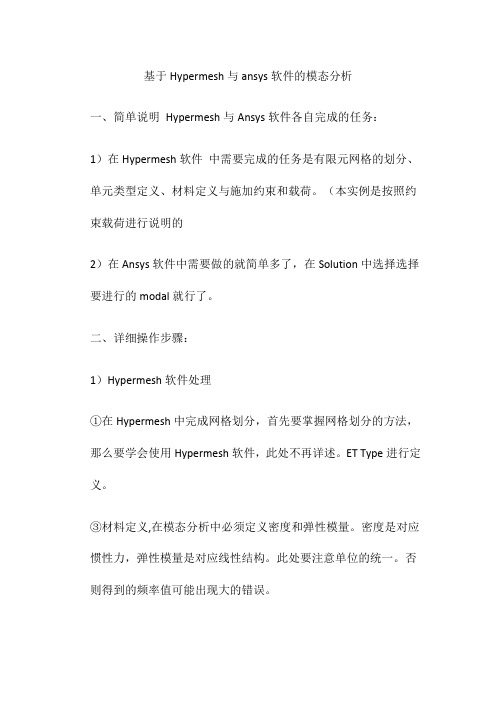
基于Hypermesh与ansys软件的模态分析一、简单说明Hypermesh与Ansys软件各自完成的任务:1)在Hypermesh软件中需要完成的任务是有限元网格的划分、单元类型定义、材料定义与施加约束和载荷。
(本实例是按照约束载荷进行说明的2)在Ansys软件中需要做的就简单多了,在Solution中选择选择要进行的modal就行了。
二、详细操作步骤:1)Hypermesh软件处理①在Hypermesh中完成网格划分,首先要掌握网格划分的方法,那么要学会使用Hypermesh软件,此处不再详述。
ET Type进行定义。
③材料定义,在模态分析中必须定义密度和弹性模量。
密度是对应惯性力,弹性模量是对应线性结构。
此处要注意单位的统一。
否则得到的频率值可能出现大的错误。
④施加约束和载荷(当然在Ansys中做谐响应分析时可以不在Hypermesh中施加载荷)⑤以上步骤完成之后,就要在Ansys进行模态分析。
在进行模态分析之前我们还是要注意出现的问题,这部分是本文说明的重点。
首先,其实当把网格完成之后,还需要删除三维网格以外的单元,比如二维单元、实体模型,这些都会影响有限单元的导入。
我们在划分网格时候为了方便划分网格会进行切割,同样的在我们完成网格之后还要把他们进行组合,可以用Tool中的Organize命令。
我们还会根据不同的零部件产生不同的Component,后面付给不同的单元类型要用到。
第二点,单元类型必须在Hypermesh中定义,不然无法保存成Ansys可以识别的cbd 格式;第三点,当我们完成单元类型的定义和材料属性的定义后,还要做的工作就是在Utility中选择ComponentManager,把我们定义的单元类型和材料付给具有这些性质的Component。
Ansys中打开就不会出现问题了2)Ansys软件处理①在Ansys中需要做的就相对来说简单多了,可以改变Change Jobname,Change Title。
2024新版hypermesh入门基础教程

设置接触条件等方法实现非线性分析。
求解策略
03
采用增量迭代法或牛顿-拉夫逊法进行求解,考虑收敛性和计算
效率。
实例:悬臂梁线性静态分析
问题描述
对一悬臂梁进行线性静态分析,计算 其在给定载荷下的位移和应力分布。
分析步骤
建立悬臂梁模型,定义材料属性和边界 条件;对模型进行网格划分;施加集中 力载荷;设置求解选项并提交求解;查 看和评估结果。
HyperMesh实现方法 利用OptiStruct求解器进行结构优化,包括拓扑 优化、形状优化和尺寸优化等。
3
案例分析
以某车型车架为例,介绍如何在HyperMesh中 进行拓扑优化和形状优化,提高车架刚度并降低 质量。
疲劳寿命预测技术探讨
01
疲劳寿命预测原理
基于材料疲劳性能、载荷历程等, 采用疲劳累积损伤理论进行寿命 预测。
HyperMesh实现方法
利用多物理场分析模块,定义各物理场的属性、边界 条件等,进行耦合分析。
案例分析
以某电子设备散热问题为例,介绍如何在 HyperMesh中进行结构-热耦合分析,评估设 备的散热性能。
实例:汽车车身结构优化
问题描述
针对某车型车身结构,进行刚度、模态及碰撞性能等多目 标优化。
01
02
HyperMesh实现方 法
利用疲劳分析模块,定义材料疲 劳属性、载荷历程等,进行疲劳 寿命计算。
03
案例分析
以某车型悬挂系统为例,介绍如 何在HyperMesh中进行疲劳寿 命预测,评估悬挂系统的耐久性。
多物理场耦合分析简介
多物理场耦合分析原理
考虑多个物理场(如结构、热、流体等)之间 的相互作用,进行综合分析。
hypermesh模态动刚度分析流程
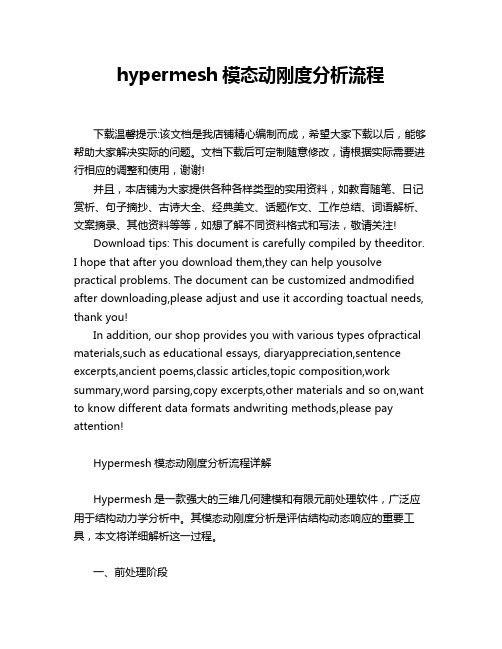
hypermesh模态动刚度分析流程下载温馨提示:该文档是我店铺精心编制而成,希望大家下载以后,能够帮助大家解决实际的问题。
文档下载后可定制随意修改,请根据实际需要进行相应的调整和使用,谢谢!并且,本店铺为大家提供各种各样类型的实用资料,如教育随笔、日记赏析、句子摘抄、古诗大全、经典美文、话题作文、工作总结、词语解析、文案摘录、其他资料等等,如想了解不同资料格式和写法,敬请关注!Download tips: This document is carefully compiled by theeditor.I hope that after you download them,they can help yousolve practical problems. The document can be customized andmodified after downloading,please adjust and use it according toactual needs, thank you!In addition, our shop provides you with various types ofpractical materials,such as educational essays, diaryappreciation,sentence excerpts,ancient poems,classic articles,topic composition,work summary,word parsing,copy excerpts,other materials and so on,want to know different data formats andwriting methods,please pay attention!Hypermesh模态动刚度分析流程详解Hypermesh是一款强大的三维几何建模和有限元前处理软件,广泛应用于结构动力学分析中。
hypermesh模态分析
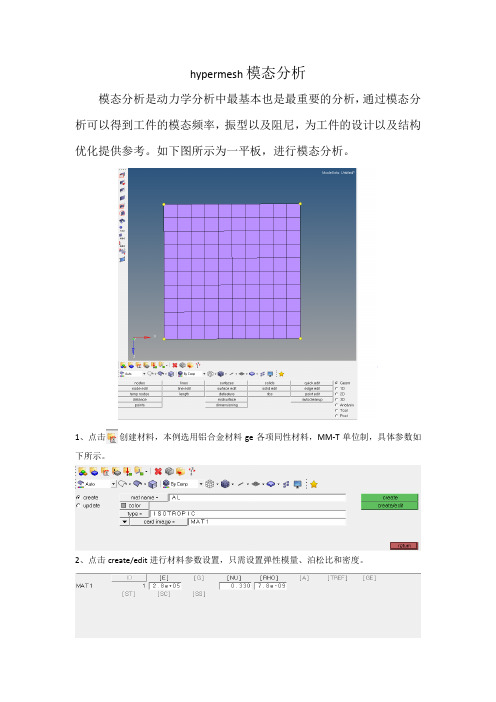
hypermesh模态分析
模态分析是动力学分析中最基本也是最重要的分析,通过模态分析可以得到工件的模态频率,振型以及阻尼,为工件的设计以及结构优化提供参考。
如下图所示为一平板,进行模态分析。
1、点击创建材料,本例选用铝合金材料ge各项同性材料,MM-T单位制,具体参数如下所示。
2、点击create/edit进行材料参数设置,只需设置弹性模量、泊松比和密度。
3、点击进行属性建立,设置如下图所示,2d单元,pshell单元,选取之前建立好的材料AL。
4、create/edit进行参数设置,设置厚度T=1点击return,属性设置完毕。
4、点击把属性赋予单元。
选择assign,comps选择平板,property选择之前建好的属性,点击assign,给网格赋予属性。
5、建立SPC约束,点击,设置如下,点击creat。
6、点击anasys,选择constrain,node选择要约束的点,点击creat,设置如下。
7、点击,card image选择eigrl,设置如下,点击creat/edit。
8、设置模态求解范围v1、v2为求解模态范围,ND为阶数,本例子求解前六阶模态。
9、点击analysis面板loadsteps,进行工况设置。
输入名字type选择mormal modes,spc选
择设置好的SPC,METHOD选择eigrl,点击creat,
10、点击edit,output选择displacement
11、设置完毕可以进行求解啦,本例用optistruct求解第一阶模态振型如下所示。
HyperMesh模态分析步骤
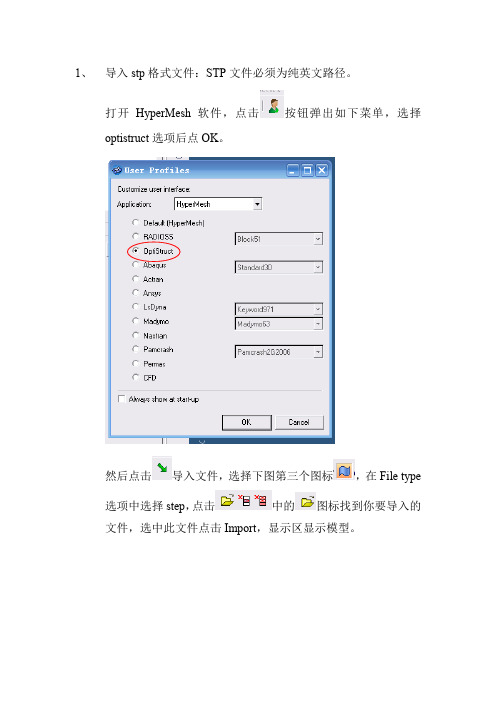
1、导入stp格式文件:STP文件必须为纯英文路径。
打开HyperMesh软件,点击按钮弹出如下菜单,选择optistruct选项后点OK。
然后点击导入文件,选择下图第三个图标,在File type 选项中选择step,点击中的图标找到你要导入的文件,选中此文件点击Import,显示区显示模型。
2、划分自由网格。
软件右下方选中3D选项,然后选择县市区下方网格划分tetramesh选项。
然后选择volume tetra选项,在element size中输入网格的大小根据模型的大小输入数值,此处我输入10,然后选中你要划分的模型变成白颜色,在点击mesh开始划分网格。
等到网格划分结束无错误,点击return返回。
左下提示栏显示为网格划分完成可以下一步操作。
3、创建定义材料。
选择右上处次位置中的model选项在变化的后的下方空白处点击右键,点击下弹菜单中create→Material菜单弹出下图,给定一个英文名字(可以不改为默认),Card image选项中选中MAT1选项,然后点击Create/Edit。
如入材料的弹性模量E、泊松比NU、密度RHO(密度单位为T/mm3一般为负9次方)。
其它都不用选择。
点击return返回。
4、创建单元属性。
还在上次的空白处点击右键,点击下弹菜单中create→property 菜单弹出下图,给定一个英文名字(可以不改为默认),Card image选项中选中PSOLID选项,再在Material选项中选中上一步你定义材料的名字***。
然后点击Create(别点错)。
5、单元属性赋予给材料。
点击软件下面菜单中的第二个图标如下图,选择update选项后,点击黄色的comps选项进入下一菜单,勾选aotu1选项后,点击右下边select,返回上一界面。
点击noproperty更改成property,再在其后面要填写的空格中点击进入选择上一步你命名的单元属性名字后自动返回上一界面。
- 1、下载文档前请自行甄别文档内容的完整性,平台不提供额外的编辑、内容补充、找答案等附加服务。
- 2、"仅部分预览"的文档,不可在线预览部分如存在完整性等问题,可反馈申请退款(可完整预览的文档不适用该条件!)。
- 3、如文档侵犯您的权益,请联系客服反馈,我们会尽快为您处理(人工客服工作时间:9:00-18:30)。
运用Hypermesh计算消声器模态
1 概述
目前许多CAE分析都采用HyperMesh进行网格划分,后期计算采用其它如Nastran,Ansys等分析软件,在多个软件之间的接口,需要设置不同的控制卡片,对于CAE分析来讲比较烦琐,过多的文件转换也容易造成信息遗漏。
HyperWorks自带的求解器RADIOSS和后处理软件HyperView可以很好的解决这个问题。
整个分析过程在同一个操作界面中可以实现。
模态分析是汽车零部件常见的分析工况,本文通过对汽车消声器的计算实例,说明HyperWorks在模态计算方面的应用。
2 消声器结构分析
消声器是汽车上重要的降噪部件。
目前消声气多注重声学方面的研究,针对其振动形式研究较少,缺少量化标准。
对消声器支架以及消声器安装设计来讲,消声器的振动研究是必要的。
本文通过对消声器进行数字化建模,计算其振动模态,并模拟在特定激励下消声器的响应,获取消声器的动力学参数。
2.1 消声器概况
利用CATIA V5R19软件中的钣金模块建立模型。
消生器内部采用焊接的方式连接。
中间的消声层采用高温耐热材料,将排气的声能转化为热能。
为提高计算效率,对模型的一些细节进行了简化。
去除焊接部位及边缘的折棱,取消外部的隔热板以及安装的支架。
模型如图1所示。
图1 几何模型
2.2 网格的前处理
对将Catia装配模型导入HyperMesh10.0进行网格划分。
消声器大部分是薄壁件,用Shell单元对消声器薄板进行划分。
导入HyperMesh的零件模型为面元素,进行相应的几何清理,利用HyperMesh里面的midsuface面板进行中面抽取操作。
对于体的部分也进行了抽取中面的操作。
分别在各个面上划分网格,为了控制网格的数量,进排气管上,以及共振腔壁面上的圆孔用小方孔近似替代见图2,内部的薄板是焊接在外层蒙皮上的,直接合并结点,将其连接为一体见图3。
图2 小孔的处理
图3 焊接部分的处理
共划分四边形单元74566个,三角形单元1088个。
消声器模型做了适当简化,将消声材料去掉,另外。
消声器采用自由模态的方法,不添加约束。
将材料特性赋给给各个Component后,对整个装配模型进行质量检查,发现模型的质量为26.5kg,而实际消声器质量为29.3kg.由于对于消声器模态来讲,质量和刚度对于模态结果非常重要,因此重新检查模型。
先前为了简化起见,将所有板金折叠部分以及外部的边棱去掉,现在将这些特征重新在有限元模型上表现出来,重新定义其厚度。
见图4。
图4 有限元模型(剖面)
2.3 有限元计算结果
利用RADIOSS中的Lanczos方法计算消声器模态,利用HyperView软件获取最后的结果:
图5 有限元计算结果
2.4 模态结果分析与试验结果对比
表1 模态结果分析与试验结果对比
从模态结果上来看,由于受到试验条件的限制。
消声器的主要模态集中在右侧隔热板上,隔热板是利用铆钉和支架焊接在一起的。
此处的模态频率比较低,而消声器的钢板是焊接和卷装在一起的,作为一个整体频率普遍较高
结果分析:从结果来看,总体上试验结果与计算结果是相户吻合的,低阶时由于右侧隔热板与消声器之间是铆接的,而且存在缝隙和过赢配合。
由此导致有限元拟合比较困难,误差较大,但从高阶上看基本与试验结果相吻合,可以反映消声器真实的模态。
自由状态下的消声器在200Hz以下的振动模态一共有69阶(除去6个刚体模态外),其中消声器外部蒙皮的模态一共是19个,其余50个模态都为消声器内部隔板的模态。
在消声器蒙皮的模态中包含右侧(以进气管为前,排气管为左)11个,左侧4个,上侧1个,后侧2个,前面1个模态。
消声器内部的隔板比较薄(0.6mm),刚度低,低阶模态集中比较多。
消声器右侧是共振腔,结构比较简单,都
是大面积的薄板,低阶模态主要集中在这里,在消声器左侧由于布置了进排气管以及其他的小面积隔板,结构刚度较大,低阶模态相对少。
从消声器的原理来讲,右侧共振腔内低的模态有利于被低频气流激发共振,吸收气流能量,达到降低噪音的目的。
消声器蒙皮振动在上下方向以及前后方向振动低频比较低,一共5个,而且都在158Hz以上,在考虑气流激励频率的情况下,这些激励产生共振的可能比较小,在消声器的前后以及上下端面部位会用钢带与支架连接,不希望消声器产生过大振动而对支架产生疲劳损伤。
3 结论
利用HperMesh10.0对卡丁车和消声器进行网格划分,由于消声器都是薄壁件,所以使用Shell单元划分,2D单元的网格质量很容易控制,且数量较少,计算效率高。
HyperMesh10.0提供的抽取中面的面板,很容易从几何特征中获得中面。
这要比利用四面体划分网格获得网格数目少的多,而且网格质量更好。
在HyperMesh的面板中可以调入RADIOSS和HyperView直接计算。
从模态计算结果来看与试验结果偏差不大,对于后续的设计或评价有参考意义。
